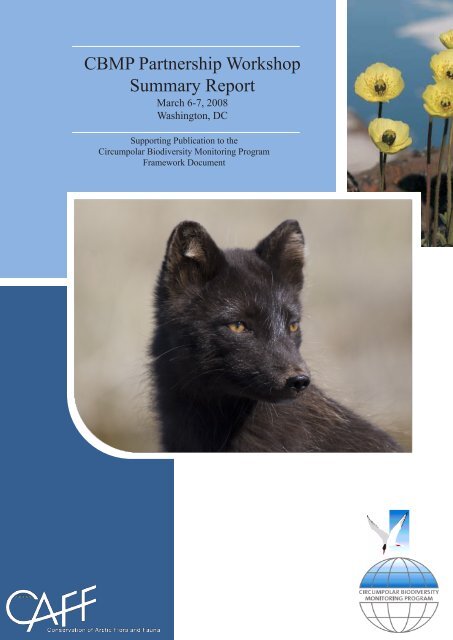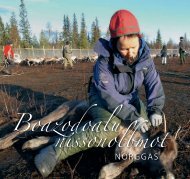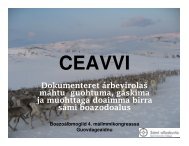Appendix 1. List of Workshop Participants - Arctic Portal Library
Appendix 1. List of Workshop Participants - Arctic Portal Library
Appendix 1. List of Workshop Participants - Arctic Portal Library
Create successful ePaper yourself
Turn your PDF publications into a flip-book with our unique Google optimized e-Paper software.
CBMP Partnership <strong>Workshop</strong><br />
Summary Report<br />
March 6-7, 2008<br />
Washington, DC<br />
Supporting Publication to the<br />
Circumpolar Biodiversity Monitoring Program<br />
Framework Document
CAFF Designated Agencies:<br />
Environment Canada, Ottawa, Canada<br />
Finnish Ministry <strong>of</strong> the Environment, Helsinki, Finland<br />
Ministry <strong>of</strong> the Environment and Nature, Greenland Homerule, Greenland (Kingdom <strong>of</strong><br />
Denmark)<br />
Faroese Museum <strong>of</strong> Natural History, Tórshavn, Faroe Islands (Kingdom <strong>of</strong> Denmark)<br />
Icelandic Institute <strong>of</strong> Natural History, Reykjavik, Iceland<br />
Directorate for Nature Management, Trondheim, Norway<br />
Russian Federation Ministry <strong>of</strong> Natural Resources, Moscow, Russia<br />
Swedish Environmental Protection Agency, Stockholm, Sweden<br />
United States Department <strong>of</strong> the Interior, Fish and Wildlife Service, Anchorage, Alaska<br />
Photography by:<br />
Carsten Egevang/ARC-PIC.COM<br />
For more information please contact:<br />
CAFF International Secretariat<br />
Borgir<br />
Nordurslod<br />
600 Akureyri<br />
Iceland<br />
Phone: +354 462-3350<br />
Fax: +354 462-3390<br />
Email: caff@caff.is<br />
Internet: http://www.caff.is<br />
Supported by:<br />
___ CAFF Designated Area<br />
Sponsored by the US Fish and Wildlife Service and hosted by the World Wildlife Fund, with<br />
logistical support from the World Conservation Union
Table <strong>of</strong> Contents<br />
INTRODUCTION 1<br />
GUEST SPEAKER PRESENTATIONS 1<br />
WORKING GROUP SESSIONS 4<br />
PANEL DISCUSSION 5<br />
CONCLUSIONS & NEXT STEPS 6<br />
APPENDIX <strong>1.</strong> LIST OF WORKSHOP PARTICIPANTS 8
<strong>1.</strong> INTRODUCTION<br />
The workshop, “Towards Enhanced Understanding and Conservation <strong>of</strong> <strong>Arctic</strong><br />
Biodiversity: The Circumpolar Biodiversity Monitoring Program (CBMP)” was held on<br />
March 6-7, 2008 in Washington, DC at the headquarters <strong>of</strong> the US World Wildlife Fund<br />
(WWFUS). The goal <strong>of</strong> the workshop was “to develop a multi-stakeholder consortium<br />
with the common objective <strong>of</strong> advancing our understanding and conservation <strong>of</strong> the<br />
<strong>Arctic</strong>’s biodiversity.”<br />
The workshop gathered over 50 participants from a broad spectrum <strong>of</strong> scientific<br />
research, natural resource management, and environmental advocacy for a lively<br />
dialogue about the CBMP. The following is a summary <strong>of</strong> the presentations and<br />
discussions that took place during the two days, as well as the key findings and priorities<br />
for action that emerged.<br />
2. GUEST SPEAKER PRESENTATIONS<br />
Guest speakers provided workshop participants with an overview <strong>of</strong> the CBMP and<br />
insight into how CBMP partnerships are adding value to monitoring programs currently<br />
underway. Bill Eichbaum <strong>of</strong> WWFUS provided Welcoming Remarks at the start <strong>of</strong> Day<br />
One.<br />
Mike Gill, Chair, CBMP, “Overview <strong>of</strong> the Circumpolar Biodiversity Monitoring<br />
Program”<br />
Mike highlighted the serious challenges facing the <strong>Arctic</strong> and its globally significant<br />
biodiversity, including climate change, habitat alteration, and development pressures.<br />
Despite the $300+ million dollars expended annually on biodiversity monitoring in <strong>Arctic</strong><br />
regions, the absence <strong>of</strong> ongoing coordination and long-term commitment results in<br />
incomplete coverage, the failure to detect and comprehend changes, and weak ties to<br />
both the public and political process.<br />
The CBMP is an international network working to improve detection, understanding and<br />
reporting <strong>of</strong> <strong>Arctic</strong> biodiversity trends. The program’s goal is to add value to existing<br />
monitoring through the identification <strong>of</strong> significant biodiversity trends, underlying<br />
causes, and emerging pressures from a broad circumpolar perspective. Stemming from<br />
the <strong>Arctic</strong> Climate Impact Assessment’s (ACIA) recommendation to “expand and<br />
enhance long-term <strong>Arctic</strong> biodiversity monitoring”, CBMP is the cornerstone program<br />
for the <strong>Arctic</strong> Council’s Conservation on <strong>Arctic</strong> Flora and Fauna (CAFF) Working Group.<br />
The program was established in 2005 and is producing results, but additional<br />
partnerships and funding will be required to realize the full scope <strong>of</strong> its vision.<br />
1
Christoph Zöckler, United Nations Environment Programme (UNEP) - World<br />
Conservation Monitoring Centre (WCMC), “CBMP: A Barometer for the <strong>Arctic</strong><br />
Environment”<br />
Citing numerous examples <strong>of</strong> <strong>Arctic</strong> bird species where problematic monitoring data<br />
resulted in an incomplete “picture” <strong>of</strong> changes underway, Christoph spoke to the need<br />
for integrated monitoring and data collection in order to detect and understand<br />
population trends and fluctuations. Complete and consistent data sets and monitoring<br />
are the necessary precursor to informed management decisions.<br />
The Circumpolar Seabird Group’s (CBird) Seabird Information Network (SIN) is a CBMP<br />
pilot project working to create an integrated data management system model.<br />
Individual monitoring programs will continue to house their own web data servers but<br />
will link to a central server housed at UNEP-WCMC. The central server will integrate<br />
data and information to generate circumpolar status and trends assessments and allow<br />
for correlation <strong>of</strong> the data with other abiotic data. Ideally, the web portal will allow the<br />
user to ‘drill down’ from an indice to a specific indicator to specific information for a<br />
given region or specific wildlife population.<br />
Don Russell, Circum<strong>Arctic</strong> Rangifer Monitoring & Assessment (CARMA) Network<br />
CARMA is building local capacity and integrating and standardizing monitoring<br />
approaches with the objective <strong>of</strong> sharing data about wild caribou populations<br />
throughout the circumpolar world. CARMA’s key interests relate to the role <strong>of</strong> winter<br />
areas and seasonal ranges, differences between herds, underlying causes <strong>of</strong> herd<br />
growth and decline, the role <strong>of</strong> predators and human harvest, and mechanisms for<br />
adaptation.<br />
CARMA focuses on 14 reference herds located across the <strong>Arctic</strong>. The program has<br />
developed manuals to facilitate standardization <strong>of</strong> data collection and monitoring<br />
protocols among existing programs. CARMA is engaging local communities through data<br />
collection and interpretation, as well as documenting change through multimedia.<br />
CARMA’s pilot project with CBMP involves reconciling its internal data sets and<br />
determining the best mechanisms to link to CBMP indicators.<br />
David Carlson, Director, International Polar Year (IPY) Programme Office, “IPY: An<br />
Opportunity and Urgency for CBMP”<br />
The International Polar Year (IPY) presents a unique two year window in which <strong>Arctic</strong><br />
researchers can establish long-term initiatives and systems. Circumpolar scientists need<br />
the ability to integrate geophysical data with biological data. They also need to hone<br />
their predictive abilities versus “monitoring for monitoring’s sake”. The key legacy <strong>of</strong> IPY<br />
will be partnerships: CBMP has a valuable role to play in ensuring that short-term<br />
research initiatives are brought “into the fold” <strong>of</strong> scientific and policy discourse.<br />
2
Mike Gill, Chair, CBMP, “The Way Forward: CBMP Five Year Vision/Plan, Current<br />
Status and Outstanding Needs”<br />
Mike distilled the long-term vision <strong>of</strong> the CBMP into four primary goals:<br />
� coordinated and integrated research and monitoring;<br />
� community-based monitoring (CBM) utilized and promoted;<br />
� involvement <strong>of</strong> <strong>Arctic</strong> peoples in monitoring and results interpretation; and,<br />
� current, timely, and accurate information on <strong>Arctic</strong> biodiversity accessible to all.<br />
The CBMP’s Five Year Implementation Plan sets out the specific activities and products<br />
required to realize this vision:<br />
PROGRAM ELEMENT KEY ACTIVITIES/PRODUCTS (BY 2012)<br />
Expert Monitoring<br />
Groups<br />
Convene 5 EMGs and complete Integrated Monitoring Plans for each<br />
<strong>Arctic</strong> Biodiversity Complete pan-<strong>Arctic</strong> monitoring inventory, capacity assessment and<br />
Monitoring Strategy final strategy to address gaps<br />
Data Management Create fully operational Web-based data portal and underlying data<br />
management structures<br />
Capacity Building Convene CBM Guidance Group and produce CBM Program<br />
Communications<br />
Development and Best Methods manuals<br />
Establish communications links between scientists and communities<br />
involved in monitoring<br />
Reporting Complete Phase I and II <strong>of</strong> CBMP indicators and indices and produce<br />
ongoing “State <strong>of</strong> the <strong>Arctic</strong>” report cards<br />
The CBMP’s implementation milestones will support and inform the activities <strong>of</strong> other<br />
strategically linked <strong>Arctic</strong> biodiversity initiatives and programs where possible. For<br />
example, the development <strong>of</strong> the CBMP’s Biodiversity Indicators and Indices will be a<br />
key contribution to CAFF’s <strong>Arctic</strong> Biodiversity Assessment (ABA), forming the foundation<br />
<strong>of</strong> the ABA’s summary report in 2010.<br />
D.A. (Skip) Walker, University <strong>of</strong> Alaska Fairbanks (UAF), “Monitoring Spatial and<br />
Temporal Changes in <strong>Arctic</strong> Vegetation”<br />
Skip provided a compelling case for monitoring arctic vegetation and plant species<br />
diversity, citing the pr<strong>of</strong>ound impacts climate-related vegetation changes could have for<br />
every key aspect <strong>of</strong> the <strong>Arctic</strong> system. Normalized Difference Vegetation Index (NDVI) –<br />
a satellite derived measure <strong>of</strong> plant biomass - has generally increased across the <strong>Arctic</strong>,<br />
but there is insufficient ground data for scientists to establish a strong causal<br />
relationship. Poor biomass data, cover data, inconsistent sampling methods and<br />
3
incomplete plant inventories common to <strong>Arctic</strong> monitoring efforts limit the usefulness<br />
<strong>of</strong> research efforts at the decision making level.<br />
There is a serious need for standardized protocols for baseline time-series observations<br />
<strong>of</strong> biomass and species diversity at a network <strong>of</strong> sites. Observations should be made<br />
along the complete climate gradient and at several relevant scales (from plot to planet).<br />
Vegetation monitoring should be closely coordinated with other terrestrial monitoring<br />
programs. Programs such as the Global Observation Research Initiative in Alpine<br />
Environments (GLORIA) and the CBMP are excellent examples <strong>of</strong> how monitoring efforts<br />
can be designed and/or streamlined to better meet these objectives.<br />
3. WORKING GROUP SESSIONS<br />
During the afternoon <strong>of</strong> Day One, participants broke into working groups modelled after<br />
the CBMP’s proposed EMGs: Coastal, Marine, Terrestrial Vegetation, Terrestrial Fauna,<br />
and Freshwater. The working groups discussed and brainstormed around the following<br />
themes:<br />
User Needs: What are the key priority actions/needs to be addressed by CBMP?<br />
Partnerships: Who needs to be involved in these priority actions/needs?<br />
Action Plans: What steps are required to link these needs with potential partners?<br />
Other Products/Activities: What products/activities might CBMP be missing?<br />
Sustainability: How do we sustain the CBMP and the programs underpinning it?<br />
The major points that emerged from the working group presentations on the morning <strong>of</strong><br />
Day Two are summarized below.<br />
USER NEEDS<br />
� Develop overarching conceptual frameworks that identify what is to be<br />
monitored<br />
� Improve scientific community’s predictive capacity<br />
� Create harmonized monitoring standards and protocols<br />
� Tackle challenges posed by proprietary data and existing data portals i.e. avoid<br />
redundancy and capture connectivity <strong>of</strong> systems in Web portal<br />
� Establish the links between scientific monitoring results and human systems to<br />
better inform adaptation and mitigation strategies<br />
PARTNERSHIPS<br />
� Industry sectors and Northern communities<br />
� Key conventions<br />
� Appropriate age7ncies, NGOs and responsible countries<br />
4
� Observatory networks i.e. Global Earth Observation System <strong>of</strong> Systems,<br />
Circum<strong>Arctic</strong> Environmental Observatories Network, Global Observation<br />
Research Initiative in Alpine Environments, etc.<br />
� Agencies with mapping capabilities<br />
� Communications and media “specialists” i.e. National Geographic<br />
ACTION PLANS<br />
� Develop accessible information<br />
around what CBMP<br />
partnerships entail and<br />
benefits and incentives on a<br />
sector-specific basis<br />
OTHER PRODUCTS/ACTIVITIES<br />
� Accessible, end user-focused<br />
communications products that<br />
tell a compelling story i.e.<br />
videos, web cams, “state <strong>of</strong>”<br />
publications, etc.<br />
SUSTAINABILITY<br />
� Develop clear strategy to link CBMP with individual country priorities and<br />
mandates<br />
� Choose indicators with circumpolar relevance and resonance<br />
� Expand concern about the <strong>Arctic</strong> beyond the <strong>Arctic</strong> itself<br />
� Lack <strong>of</strong> binding country-level commitments is a limiting factor<br />
� Enlist “champions” <strong>of</strong> the program<br />
� Differences in conceptual approaches to monitoring biodiversity will pose a<br />
challenge i.e. population approaches versus Valued Ecosystem Components<br />
(VECs)<br />
4. PANEL DISCUSSION<br />
A panel consisting <strong>of</strong> David Carlson (IPY), Fae Korsmo (National Science Foundation),<br />
Craig Fleener (Gwich’in Council International), and Skip Walker (UAF) elaborated on how<br />
best to expand CBMP targeted partnerships and sustain the CBMP and its related<br />
monitoring networks.<br />
David Carlson – Think “accelerate”. The pace <strong>of</strong> change in the <strong>Arctic</strong> necessitates action<br />
on these long-standing issues. IPY should be utilized as much as possible. Effective<br />
communications are key: putting out useful products will enable the program to expand<br />
5
and do its work. CBMP needs to think in predictive mode, even if problems are decadal<br />
in nature. CBMP needs to think in terms <strong>of</strong> trophic levels, from “biomes to genomes”.<br />
Craig Fleener – Human biodiversity is as important as flora and fauna. The CBMP should<br />
think beyond individual stakeholders to large groups being impacted. Northern<br />
communities need the<br />
tools to adapt and the<br />
ability to access resources.<br />
The CBMP needs a vision<br />
that others can see,<br />
imagine, and sign on to.<br />
Sell the message, get<br />
people excited, take<br />
manageable steps and<br />
create useful, scientific,<br />
and “popular” products.<br />
Skip Walker – The CBMP<br />
needs to encourage young<br />
scientists to be champions,<br />
encourage more dialogue between disciplines through its EMGs, and address the<br />
important issues outside and beyond the framework <strong>of</strong> biodiversity for maximum<br />
resonance with the public and decision makers.<br />
Fae Korsmo – There are three primary needs that the CBMP must address: the<br />
integration <strong>of</strong> projects, people, and process; the standardization <strong>of</strong> methodology to<br />
create easy, useful tools for people; and the dissemination <strong>of</strong> compelling stories aided<br />
by effective branding and communications.<br />
The major points raised by the workshop participants during the ensuing discussion<br />
included:<br />
� Communications are key: make issues relevant, keep the science accessible,<br />
piggyback on existing initiatives, create a space for storytelling<br />
� <strong>Arctic</strong> residents should understand the “pros” <strong>of</strong> change as well as “cons”<br />
� CBMP can be a catalyst for sharing between and within disciplines<br />
� CBMP needs to adapt in response to where the funding/research emphasis is<br />
5. CONCLUSIONS & NEXT STEPS<br />
The CBMP Partnership <strong>Workshop</strong> assembled over 50 participants for a multi-disciplinary<br />
and lively dialogue about the program’s opportunities and challenges as it transitions<br />
6
towards implementation. During two days <strong>of</strong> structured discussions, the group’s focus<br />
shifted from the urgency <strong>of</strong> the “internal” programming functions that the CBMP is<br />
proposing (i.e., EMGs and data portal) to the importance <strong>of</strong> “external” activities that will<br />
ultimately enable the CBMP to deliver on these goals: strategic partnerships, targeted<br />
and compelling communications, and long-term funding commitments from countries<br />
and key organizations.<br />
The short and mid-term direction <strong>of</strong> the CBMP, as envisioned by workshop participants,<br />
could be described by the flow chart below:<br />
<strong>Participants</strong> repeatedly stressed the importance <strong>of</strong> demonstrating value and<br />
programming relevance to CBMP’s existing and potential partners in the short-term. In<br />
the coming months, CBMP staff will endeavour to integrate this direction into its<br />
activities and expand the dialogue through new partnerships as it begins to deliver on its<br />
vision <strong>of</strong> harmonized, enhanced <strong>Arctic</strong> biodiversity monitoring.<br />
7
<strong>Appendix</strong> <strong>1.</strong> <strong>List</strong> <strong>of</strong> <strong>Workshop</strong> <strong>Participants</strong><br />
<strong>Workshop</strong> Steering Committee Chair<br />
Janet Hohn<br />
US Fish and Wildlife Service<br />
<strong>Workshop</strong> Facilitator <strong>Workshop</strong> Organizer<br />
Elizabeth De Santo IUCN Megan Hansen IUCN<br />
Rapporteurs<br />
Michael Svoboda Environment Canada Danielle Rappaport IUCN<br />
Jane Koepke Jane <strong>of</strong> all Trades Consulting Nirmal Bhagabati IUCN<br />
Blake Audsley IUCN Sheila Van Der Maas IUCN<br />
Kira Goetschius IUCN<br />
<strong>Participants</strong><br />
Ann Gordon US Department <strong>of</strong> State Joseph Culp, Dr. Environment Canada<br />
Anne Bolen SeaWeb Lisa A. Monzon National Geographic<br />
Christoph Zockler UNEP – WCMC Marie Karlberg David and Lucile Packard<br />
Foundation<br />
Craig Fleener Gwich’in Council International Michael Baffrey Exxon Valdez Oil Spill Trustee<br />
Council<br />
Dag Von Graven Norwegian Polar Institute Mikaila Milton National Science Foundation<br />
Dave Carlson IPO Mike Gill Environment Canada<br />
Don Russell CARMA Mike Simpkins US Marine Mammal Commission<br />
Donald McLennan Parks Canada Paul Geissler US Geological Survey<br />
Earl Saxon IUCN Peter Ward US Fish and Wildlife Service<br />
Falk Huettman University <strong>of</strong> Alaska Fairbanks Randy Hagenstein The Nature Conservancy<br />
Fae Korsmo National Science Foundation Reidar Hindrum Norwegian Directorate for Nature<br />
Management<br />
Flemming Merkel, Dr. Greenland Institute <strong>of</strong> Natural<br />
Resources<br />
Risa Smith Environment Canada<br />
Fred Munson 444S Foundation Robin Tuttle NOAA National Marine Fisheries<br />
Service<br />
Fred Wrona University <strong>of</strong> Victoria Skip Walker Institute <strong>of</strong> <strong>Arctic</strong> Biology, UAF<br />
Gary Allport IUCN/Bird Life<br />
Stanislav Egorovich All-Russian Research Institute for<br />
International/Audobon Belikov<br />
Nature Protection<br />
Greg Butcher Audobon Society Tatiana Minaeva Wetlands International Russia<br />
Programme<br />
Greg Susanke EPA Thomas Barry CAFF<br />
Hans Melt<strong>of</strong>te Department <strong>of</strong> <strong>Arctic</strong><br />
Environment (DE)<br />
Timothy Johnson UNEP – WCMC<br />
Harlan Cohen IUCN Global Marine<br />
Toral Patel-Weynand, US Geological Survey<br />
Programme<br />
Dr.<br />
Jen Palmer IUCN Torre Stockard National Geographic<br />
Jim Reist, Dr. Fisheries and Oceans Canada Vida Amor de paz Tropical Rainforest Foundation,<br />
Planeta Verde Television<br />
John Calder NOAA Climate Program Office William Eichbaum World Wildlife Fund<br />
John Kermond, Dr. NOAA<br />
Special thanks to <strong>Workshop</strong> Steering Committee members Robert Winfree (National<br />
Park Service), Maeve Taylor (US Fish and Wildlife Service), and Nick Kulibaba (IUCN-<br />
US).<br />
8





